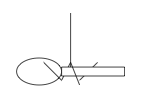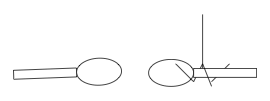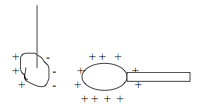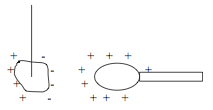Overview back to the top ↑
Objects can have positive, negative, or neutral electric charges. These charges attract and repel and can move between objects.
Grades: 3-6 (National Standards)
Time: Approximately 45 minutes
Background back to the top ↑
Everything is made of particles and these particles have electrical charges – they can be positive, negative, or neutral. Atoms can be thought of as the basic building blocks of everything in the universe. They have three components: electrons, protons, and neutrons. Electrons have a negative electric charge and we usually associate these particles with electricity. Protons have a positive electric charge, and neutrons are neutral which means they have no electric charge. Atoms normally have the same number of protons and electrons. The negative charge of the electron cancels out the positive charge of the proton giving the atom a zero net (or neutral) charge. Atoms with an electric charge are called ions. These ions either have more protons than electrons and so have a positive charge or have more electrons than protons and have a negative charge.
The protons and neutrons are glued together in what is called the nucleus (center part) of the atom. The electrons are rapidly moving around outside of the nucleus kind of like a swarm of bees (the hive would be the nucleus). However, the bees in reality would be a long way from the hive. In fact, if the hive (nucleus) were the size of a basket ball, the bees (representing the electrons) would be swarming around the outside as far as a mile away. In other words, the electrons take up almost all of the space of an atom. The next closest nucleus would be a mile away. The nuclei of atoms are locked inside the atom and are not free to travel to other atoms. However, the swarming electrons are free to move. In fact they are freer to move in some substances than others.
Electrons may travel from one material to another just by contact. This is because some materials have a greater “like” for electrons and will “steal” electrons from materials with a lesser “like” for electrons. For instance, a plastic spoon has a greater “like” for electrons than cotton. When rubbed together, the plastic spoon will attract and steal electrons from the cotton. This means the spoon has a greater number of electrons than protons making it have a negative charge. Since the cotton lost some electrons, it is now positively charged (since it now has more protons than electrons). Saran Wrap has even a greater like for electrons than plastic spoons. When rubbed together, the Saran Wrap “steals” electrons from the spoon making the spoon positive. However, only so many electrons can be “stolen” because the substance becomes more positive from losing electrons and holds on to its remaining electrons even harder. If two materials have the same electric charge they will “not like” or repel each other (push each other away). If they have opposite charges, they will “like” each other causing them to be attracted so they come together.
A neutral object, one with equal numbers of protons and electrons, can also appear to be and behave as if it is charged, by having its charges rearranged. This is called charge by induction. This can happen in materials that are poor conductors of electric charges, such as foam, when they are close to highly charged objects. For example if you bring a highly negatively charged object, such as a plastic spoon near a neutral poor conductor, such as a foam peanut, the positive charges in that peanut will collect on the end nearest to the spoon, because the positive charges in the peanut are attracted to the negative charges in the spoon. The foam peanut is now charged by induction, even though overall it is still neutral (has no charge).
We're familiar with electric charges from: electricity we use everyday, rubbing your feet on carpet to build up a charge to give a shock, and making your hair stand up by rubbing a balloon on it. The human body can detect large electric fields. Although the body is neutral (net zero charge), sometimes the positive or negative charges can move to one side of a body part giving it a charge. This charge by induction causes hair to stand up (every hair repels each other since they have the same charge). During thunderstorms, some people feel their hair standing up due to their bodies becoming charged by the induction because of the charged cloud above them. This is actually a very dangerous situation as it means that they are likely candidates for a lightning strike and should seek shelter if possible (and if it isn't too late).
Different particles have different charge properties and particle physicists use these charges to identify different particles and study their interactions. For example, if you know that one particle is negatively charged and another particle is repelled by it, then you can infer that this particle is also negatively charged.
The materials used in this exercise are nonconductors – charges do not move easily through them. Some everyday nonconductors are rubber and plastic. This means electrons will not travel very far within the material, but will move between surfaces that are in contact. The charges are static (unmoving) and nonconductor materials keep their charges for a while. These experiments work best in dry air. Humidity makes these experiments difficult because water vapor is a polar molecule which means that it is attracted to anything that has a charge and so the water molecules will steal charges off any material. When there is less water vapor, materials can retain charges for longer periods of time making winter an ideal time to perform these experiments. If it is humid, use a hair dryer to dry the objects, surfaces, and air around the work area.
Objective back to the top ↑
Charge different objects and observe their interactions.
Materials back to the top ↑
Each group needs:
- copy of worksheet (printed out on letter – 8.5 × 11 inch paper)
- pencil
- cellophane tape (invisible tape)
- Paper clip unbent so it is in the shape of a W with a 12" long string or thread (crochet thread or thing kite string work well) tied in the middle (prepare beforehand).

- Packing peanut (puffed wheat works as a substitute)
- Plastic spoons (2)
- Saran Wrap or other static plastic wrap (2 sheets/student that are at least 8x10")
- Cotton clothing
Procedure back to the top ↑
This activity works well in small groups, ideally 6 students with one adult to a group.
For each group:
- Take two pieces of invisible tape about 4-5 inches (10cm) long and stick them to the table with only about 1/4 of an inch sticking out over the edge (for a tab). Pull them up off of the table, one in each hand, and slowly bring them together facing each other (front-to-front or back-to-back is fine).
Record your observations on the worksheet (A) with the answers to these questions.
Question: Do they attract or repel each other?
Question: Does this mean they have the same or opposite charges?

- Tape one piece of invisible tape about 4–5 inches long on the table with a 1/4 inch tab. Stick an identical piece of tape on top of the first piece but leave 1/4 inch of it unstuck for a tab. Pull the bottom tape up so that they are still together but no longer on the table. Next pull them apart and then slowly bring the tape pieces together (they should not touch). Record your observations on the worksheet (B)and answer these questions.
Question: Do they attract or repel each other?
Question: Does this mean they have the same or opposite charges? - Using the paper clip that is in the shape of a W on the string, tape the end of the string to the table so that the paper clip hangs freely away from anything else. Hold the handle of one of the plastic spoons and rub the rest of it with Saran Wrap – this spoon is now charged. Carefully balance this charged spoon on the W support clip so that it is free to spin (be sure not to touch the charged end of the spoon).

- Charge the other plastic spoon in the same way and slowly bring it towards to the suspended spoon. Record your observations on the worksheet (C) and answer these questions.
Question: Do they attract or repel each other?
Question: Does this mean they have the same or opposite charges?

- Now rub the spoon in your hand on your cotton clothing and bring it near the charged suspended spoon. Record your observations on the worksheet (D) and answer these questions.
Question: Do they attract or repel each other?
Question: Does this mean they have the same or opposite charges? - Replace the spoon on the W clip with a packing peanut – this peanut is neutral (it is not negatively or positively charged). Rub a plastic spoon with the Saran Wrap to charge it. Slowly bring the charged spoon near (but not touching) the neutral packing peanut. Record your observations on the worksheet (E) and answer these questions.
Question: Do they attract or repel each other?
Question: Does this mean they have the same or opposite charges?
If the same wrap is being used over and over, it may lose its attraction for the spoon and not “steal” as many electrons. A fresh sheet will work better. - Now, rub the spoon on your cotton clothing and bring it near the packing peanut without touching it. Record your observations on the worksheet (F) and answer these questions.
Question: Do they attract or repel each other?
Question: Does this mean they have the same or opposite charges?
Results and Discussion back to the top ↑
| A. | Tape on table: | Repel |
| Charges: | Same |
The pieces of tape will repel each other because both will have the same charge. We can't tell if this same charge is positive or negative because like charges always repel. The tape could be positive or negative depending on the tape used and the surface it was stuck to. If you want to know which charge it is, rub a plastic spoon on cotton and bring the spoon near the tape. The spoon will be negatively charged, so if it attracts the tape, that means the tape is positively charged. If the spoon repels the tape then the tape is negative.
| B. | Tape on top: | Attract |
| Charges: | Opposite |
The pieces of tape will have opposite charges when pulled apart. The top tape will have the opposite charge to the bottom tape so they will attract each other. We cannot tell which is positive or negative, we just know that they are oppositely charged because they attract. If you want to know which charge it is, follow the instructions under A.
| C. | Spoons with wrap: | Repel |
| Charges: | Same |
They will repel each other which indicates that they have the same charge. Once again, we canŐt tell if the spoons are positive or negative, just that the charges are the same because they repel. If you want to know which charge it is, follow the instructions under A (a plastic spoon rubbed with Saran Wrap makes the spoon positively charged).
| D. | Spoons with cotton: | Attract |
| Charges: | Opposite |
The spoons will attract each other since they have opposite charges. Rubbing Saran Wrap makes a spoon positive while rubbing cotton makes a spoon negative, so one spoon is positive and one spoon is negative.
| E. | Spoons with wrap &peanut: | Attract |
| Charges: | Opposite |
The spoon and foam peanut will be attracted to each other which indicates that they are oppositely charged. However, this is not the case. Neutral objects can behave as if they are charged if their charges get rearranged because they are close to highly charged objects. The foam peanut is a very poor conductor of charges, so when the highly positively charged spoon comes close to the peanut, the negative charges in the peanut are attracted to the spoon and move to that side.

| F. | Spoons with cotton &peanut: | Attract |
| Charges: | Opposite |
The spoon and foam peanut will be attracted to each other which indicates that they are oppositely charged. This is not the case, as in E. The negatively charged spoon will attract the negative charges in the peanut toward it.
How do we know it is charged by induction instead of just being charged like the tape? Objects charged by induction have their charges rearranged depending on the charge of the object near it, so it will attract both a positively charged and a negatively charged object because it has no charge of its own.

Further Questions:
The universe is made of many different particles, some with charges. Electrons are negatively charged and protons are positively charged. What would happen an electron approached a proton? (It would be attracted by it because they have opposite charges. If they didn't attract each other, we wouldn't have atoms because there would be nothing to hold the electrons to the atoms.)
What would happen if a proton approached another proton? (They would repel each other. The reason that they still stick together in the nucleus of an atom is because of the Strong Force, which is a force of attraction within the nucleus, that is stronger than the electric force. Very large nuclei, that have lots of protons that repel each other, have a harder time sticking together and can be very unstable (and therefore radioactive)).
Follow Up Activities back to the top ↑
- Ask Mr. Marks for more information about electric charge and particle detectors and accelerators
- Try the “Invisible Investigations” and “Magnet Mania” lesson plans.
- Check out the site www.molecularium.com to learn more about molecules and atoms.
National Standards back to the top ↑
This lesson plan addresses the following national standards in science and math:Science
- Standard A – Science as Inquiry
Students should develop abilities necessary to do scientific inquiry and an understanding about scientific inquiry. - Standard B – Physical Science
Students should develop an understanding of the properties of objects and materials including electricity. - Standard D – Earth and Space Science
Students should develop an understanding of properties of earth materials - Standard G – History and Nature of Science
Students should develop understanding of the nature of science.
Math
- Analyze change in various contexts
- Describe qualitative change, such as a student's growing taller.
- Data Analysis and Probability Standard - Formulate questions that can be addressed with data and collect, organize, and display relevant data to answer them
- Pose questions and gather data about themselves and their surroundings
- Sort and classify objects according to their attributes and organize data about the objects
- Design investigations to address a question and consider how data-collection methods affect the nature of the data set
- Collect data using observations, surveys, and experiments
